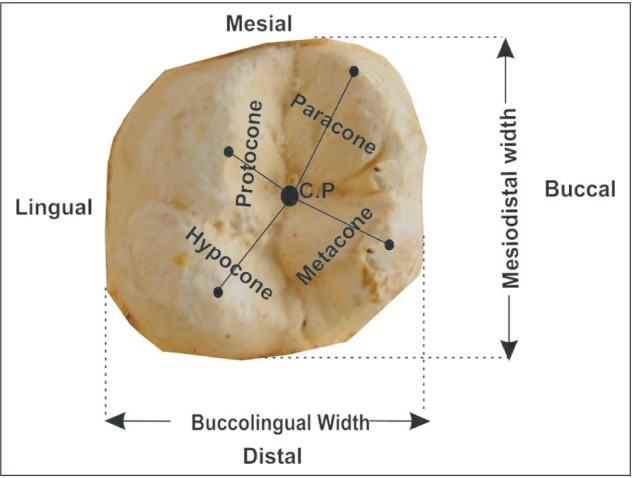Anat Cell Biol.
2019 Sep;52(3):269-277. 10.5115/acb.18.221.
Odontometric sex discrimination in young Urhobo adults of South-South Nigeria
- Affiliations
-
- 1Department of Human Anatomy and Cell Biology, Faculty of Basic Medical Sciences, College of Health Sciences, Delta State University, Abraka, Nigeria. deeboh@delsu.edu.ng
- KMID: 2459542
- DOI: http://doi.org/10.5115/acb.18.221
Abstract
- The spate of unidentified human remains as a result of kidnapping, killings, and so forth was the reason for this study. The purpose of this study was to measure the crown and cusps of each of the permanent maxillary first two molars to determine discriminant score and functions among Urhobo people of Nigeria. All Undergraduates of the Delta State University, Abraka, who are pure breeds Urhobo, form the study population. Three hundred and six subjects (171 males and 135 females), with mean age 22.88±3.34 years, participated in the study, which is based on the simple random sampling technique. All four crown widths and the four cusps of the maxillary first two molars were measured in millimeter, from a prepared study models of dental stone, and crown area, crown and cusps indices were calculated. The level of sexual dimorphism was also calculated for each parameter. Descriptive statistics was used to summarize the data while inferential statistics were used to ascertain significant sexual differences and to determine discriminant scores and functions. Statistical significance was fixed at P≤0.05. Crown and cusp dimensions of the first two permanent maxillary molars exhibited statistically significant sexual dimorphism. The highest percentage of sexual dimorphism was crown area of maxillary second molar (9.08%), followed by first molar (7.85%). Next, were metacone, paracone, disto-buccomesio-lingual, and mesio-buccodisto-lingual widths. The overall sex discriminatory precisions of the various parameters in the maxillary first two molars are good. The findings of this study are of relevance in forensic anthropology.
Figure
Cited by 1 articles
-
Quantitative and qualitative evaluation on the accuracy of three intraoral scanners for human identification in forensic odontology
Eun-Jeong Bae, Eun-Jin Woo
Anat Cell Biol. 2022;55(1):72-78. doi: 10.5115/acb.21.136.
Reference
-
1. Mealey L. Sex differences. New York: Academic Press;2000.2. Geary DC. Male, female: the evolution of human sex differences. Washington, DC: American Psychological Association;1998.3. Editors of Encyclopaedia Britannica. Sexual dimorphism [Internet]. Chicago, IL: Encyclopaedia Britannica;2006. cited 2018 Jun 1. Available from: https://www.britannica.com/science/sexual-dimorphism.4. Eboh DE, Igbigbi PS. Mandibular canine index in sex determination. J Med Biomed Res. 2011; 9:67–73.5. Eboh DE, Etetafia MO. Maxillary canine teeth as supplement tool in sex determination. Ann Biomed Sci. 2010; 9:25–30.6. Bannister LH. Teeth. In : Williams PL, Bannister LH, Berry MM, Collins P, Dyson M, Dussek JE, Fergurson MW, editors. Gray's anatomy, the anatomical basis of clinical practice. 38th ed. London: Churchill Livingstone;2000. p. 1699–1700.7. Nkejiaka C. Emergency of ethnic movements in the Niger Delta region: from voice to armed struggle in the New Democratic Era (1999-present) [dissertation]. Budapest: Central European University;2010.8. Banerjee A, Kamath VV, Satelur K, Rajkumar K, Sundaram L. Sexual dimorphism in tooth morphometrics: An evaluation of the parameters. J Forensic Dent Sci. 2016; 8:22–27. PMID: 27051219.9. Yadav AB, Angadi PV, Yadav SK. Sex assessment efficacy of permanent maxillary first molar cusp dimensions in Indians. Contemp Clin Dent. 2015; 6:489–495. PMID: 26681853.10. Manchanda AS, Narang RS, Kahlon SS, Singh B. Diagonal tooth measurements in sex assessment: A study on North Indian population. J Forensic Dent Sci. 2015; 7:126–131. PMID: 26005301.11. Sharma P, Singh T, Kumar P, Chandra PK, Sharma R. Sex determination potential of permanent maxillary molar widths and cusp diameters in a North Indian population. J Orthod Sci. 2013; 2:55–60. PMID: 24987643.12. Zorba E, Moraitis K, Manolis SK. Sexual dimorphism in permanent teeth of modern Greeks. Forensic Sci Int. 2011; 210:74–81. PMID: 21371836.13. Agnihotri G, Sikri V. Crown and cusp dimensions of the maxillary first molar: a study of sexual dimorphism in Indian Jat Sikhs. Dent Anthropol. 2010; 23:1–6.14. Macaluso PJ Jr. Sex discrimination potential of permanent maxillary molar cusp diameters. J Forensic Odontostomatol. 2010; 28:22–31. PMID: 21239859.15. Kondo S, Townsend GC, Yamada H. Sexual dimorphism of cusp dimensions in human maxillary molars. Am J Phys Anthropol. 2005; 128:870–877. PMID: 16110475.16. Eboh DE. A dimorphic study of maxillary first molar crown dimensions of Urhobos in Abraka, South-Southern Nigeria. J Morphol Sci. 2012; 29:96–100.17. Lee JH, Kim YS, Lee UY, Park DK, Jeong YG, Lee NS, Han SY, Kim KY, Han SH. Sex determination using upper limb bones in Korean populations. Anat Cell Biol. 2014; 47:196–201. PMID: 25276479.18. World Medical Association. World Medical Association Declaration of Helsinki. Ethical principles for medical research involving human subjects. Bull World Health Organ. 2001; 79:373–374. PMID: 11357217.19. Sheikhi FE, Bugaighis I. Sex discrimination by odontometrics in Libyan subjects. Egypt J Forensic Sci. 2016; 6:157–164.20. Bhavasar R, Patel FA, Soni N, Patel P, Shah V, Shah PK, Shah KM. Evaluation of sexual dimorphism by using permanent maxillary first molar in Gujarati population. J Adv Clin Res Insights. 2015; 2:16–19.21. Woelfel JB, Scheid RC. Dental anatomy: its relevance to dentistry. 6th ed. Philadelphia, PA: Lippincott Williams & Wilkins;2002.22. Bath-Balogh M, Fehrenbach MJ. Illustrated dental embryology, histology and anatomy. 2nd ed. Philadelphia, PA: Elsevier Sunders;2006.
- Full Text Links
- Actions
-
Cited
- CITED
-
- Close
- Share
- Similar articles
-
- Horizontal Facial Thirds of Young Adults in Two South-South Nigerian Ethnic Groups
- Prevalence of Malaria in Pregnant Women in Lagos, South-West Nigeria
- Systematic Review of Extended Reality Digital Therapy for Enhancing Mental Health Among South Korean Adolescents and Young Adults
- The Factors Affecting the Development of National Identity as South Korean in North Korean Refugees Living in South Korea
- Structural Equation Modeling to Assess Discrimination, Stress, Social Support, and Depression among the Elderly Women in South Korea


